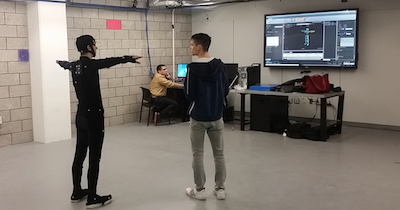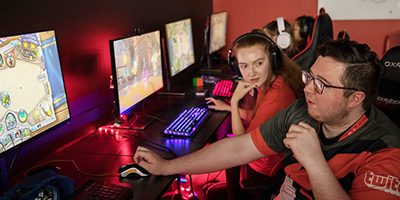Presented by Our Partner Schools:
Drexel University
Miami University
New Jersey Institute of Technology
Quinnipiac University
Rochester Institute of Technology
We spoke with some of the top programs that offer a game design major about what to look for in a top-notch program, how to make the most of your major, and the career possibilities to think about after graduation. Use this advice to discover everything you need to know as you research the best program for you in game design.
Make the Most of Your Game Design Major: Go Broad and Deep
Yes, it’s about making games. But the skills required to be a great game designer are also important 21st century skills, as Quinnipiac University points out, skills made stronger by a broad base and foundation across various disciplines. They see building games as “learning-by-doing in both a bottom up and top down process, where higher order thinking and skill at high-level planning combine with analytical thinking skills to define a system and a simulation that integrates the parts with the whole.” Quinnipiac game design students must be willing explorers in the creative process, using clear communication skills essential to successful, collaborative work.
New Jersey Institute of Technology (NJIT) encourages their students to be curious and aware of everything. Learn to see and be open to new ideas. Don't be afraid to study game design in the context of broader majors that promote the development of additional skills and talents from physical computing and interactive installations to virtual environment design as well as art history and fields that embrace storytelling.
At Miami University, Game Design students are also pushed to develop a broad profile on top of their specialization and devote significant time to networking. They like to see students to take liberal arts courses, and attend conferences and expos for additional learning and exposure. As they see it, “game design is the liberal arts education of the 21st century, becoming a game design student opens the mind to all these fields through rapidly evolving cutting-edge technology.” Students in Motion Capture Studio at New Jersey Institute of Technology in Newark, NJ.
Students in Motion Capture Studio at New Jersey Institute of Technology in Newark, NJ. What to Look for in a Strong Game Design Program
In addition to mastering the skills required for the field and broadening one’s base of knowledge through a variety of courses touched on above, top game design programs offer networking opportunities, successful placements for graduates, and hands on and research opportunities.
Co-Op Programs and Research
For example, Drexel University’s co-op program builds opportunity into the curriculum by requiring students to step out of the classroom and into industry for 6-18 months of real-world experience, working full-time for companies across the spectrum of game development and industries utilizing game technology for multiple needs. They are also fully integrated into the wide-ranging research community throughout the university, including a dedicated Immersive Research Lab. Long before it was popular, Drexel students were taking immersive media classes, which have become so popular that Drexel now offers a full bachelors program, as well as a minor, in VR & Immersive Media.
Areas of Focus or Tracks
As a studio-centric school, New Jersey Institute of Technology students spend 10-12 hours per week with their design critic by the 2nd year, getting critical hands-on learning and feedback. NJIT offers two distinct yet interrelated and collaborative programs, depending on students area of focus. Information Technology for students interested in coding and the mechanics of creating games, or Digital Design with a concentration in Entertainment, for students interested in the art of game design, the look and feel of a game, and character and environment design.
Mix of Skills and Learning Settings to Create Portfolios
Many incoming game design students show aptitude for math, inventiveness, logic and creativity. Rochester Institute of Technology seeks to “leverage these abilities so that students learn to create many games and other interactive projects throughout their degree. Making portfolio pieces, both solo and in teams, means that students must communicate well, handle pressure, and embrace creativity—even at the risk of failure. The students of the School of Interactive Games & Media become part of our community, learning to network with each other and the industry, which leads to their career success.”
What Careers Do Game Design Majors Pursue
A sample of outcomes and successes from our featured partners offers a closer look at the range of roles top game design graduates pursue, such as:
Drexel University’s Game and Virtual Reality Programs
You will find Drexel Dragons throughout the game industry (including Rockstar, Gearbox, NetherRealm, Turn 10, Spry Fox, EA, Insomniac, Treyarch, PHL Collective, Ghost Story Games) as well as industries that use real time interactive game technology for training, simulation, education, marketing, themed entertainment, and more. “We’re particularly excited about the entrepreneurial indies that have grown out of our program, using opportunities like our Entrepreneurial Games Studio (EGS) that give students the chance to form a company and launch titles into marketplaces with expert mentors. Drexel University offers additional incubator support, like Drexel’s Baiada Institute for Entrepreneurship and the URBN-Close Entrepreneurship Co-Op and Fellows Program.”
 Senior team, Root121 Games, took their capstone game project, Groundless, to PAX East 2018 on the way to launching on Steam, Windows 10, and Xbox. Image courtesy of Root121 Games/Drexel University.
Senior team, Root121 Games, took their capstone game project, Groundless, to PAX East 2018 on the way to launching on Steam, Windows 10, and Xbox. Image courtesy of Root121 Games/Drexel University. Miami University
Miami’s focus on innovative approaches in applied game design, which creates a host of job opportunities for game students that extend beyond traditional game companies, sets them up to become resident game experts for traditional companies by using game mechanics in conventional job roles. Students have a 94.2% placement rate with a median starting salary of $55,000. In fact, Miami University anticipates that rapidly changing trends in the game industry will result in more demand for experts in up and coming fields such as games and aging, Esports and Augmented Reality. “Our program is uniquely positioned as our faculty has been internationally recognized for their work in this field.”
 Miami University Game Design Majors collaborating with the varsity Esports team.
Miami University Game Design Majors collaborating with the varsity Esports team. Quinnipiac University
Game Design & Development graduate, Ryan O'Hara '18, is an artist, programmer and entrepreneur who released his game Time Tekker on Steam. Time Tekker has been recognized with the Best Gameplay Award (NESGD 2018); Best Use of Time (RPI's GameFest 2017); and the Golden Joystick Award (TERMINUS 2018) and, most recently, was selected by IndieGala as the premier game in a 11-game bundle promotion. Along with a teammate, Ryan also built the game Ligand Quest, which teaches pharmacology and is deployed as part of the University's nursing curriculum. His most recent game is entitled AstroViking, released in August 2018.
 Plenty of interaction and discussion for collaborative Game Design majors at Quinnipiac University.
Plenty of interaction and discussion for collaborative Game Design majors at Quinnipiac University. Rochester Institute of Technology’s game design graduates, schooled in a project-based curriculum, see 96% placement rates annually in game industry jobs that include gameplay programming, console development, game engine development, technical design, and tools programming, as well as entry-level producers and designers. “The interactivity and creativity in our programs also prepare students for related fields, especially in educational software, interactive/creative development, web/mobile development, AR/VR, visualization, and simulation/modeling.”
 Successful RIT game design students are skilled, dedicated, and resourceful. Incoming students have mathematical, inventive, logical, and creative aptitudes.
Successful RIT game design students are skilled, dedicated, and resourceful. Incoming students have mathematical, inventive, logical, and creative aptitudes. Explore Colleges For You
Connect with our featured colleges to find schools that both match your interests and are looking for students like you.
Get Started on Athletic Scholarships & Recruiting!
Join athletes who were discovered, recruited & often received scholarships after connecting with NCSA's 42,000 strong network of coaches.
Best 391 Colleges
170,000 students rate everything from their professors to their campus social scene.



